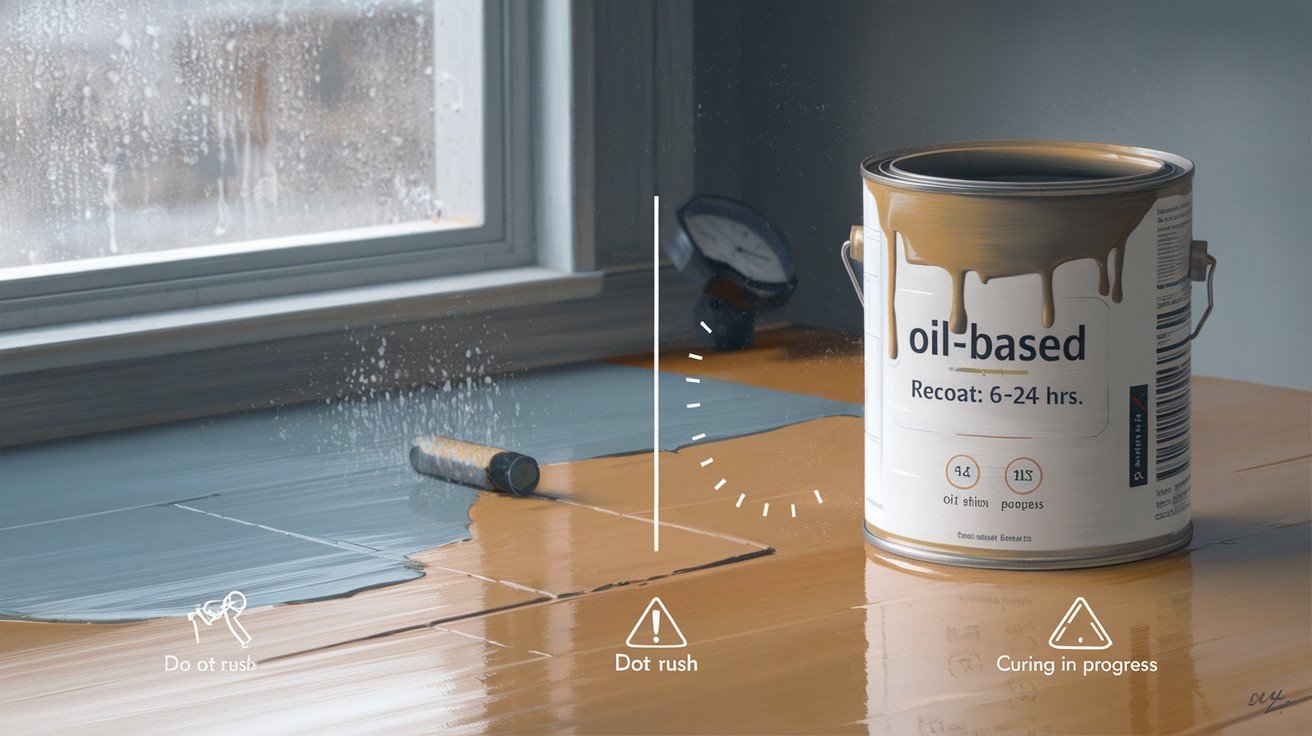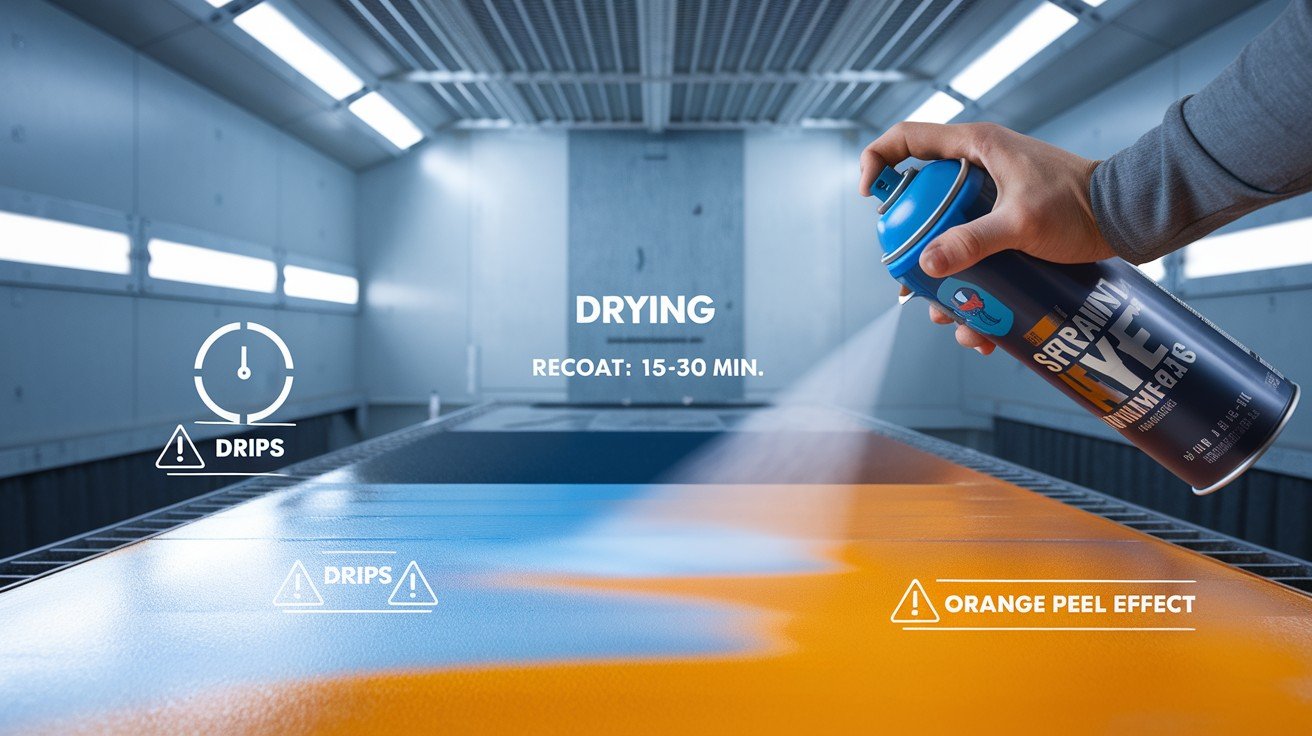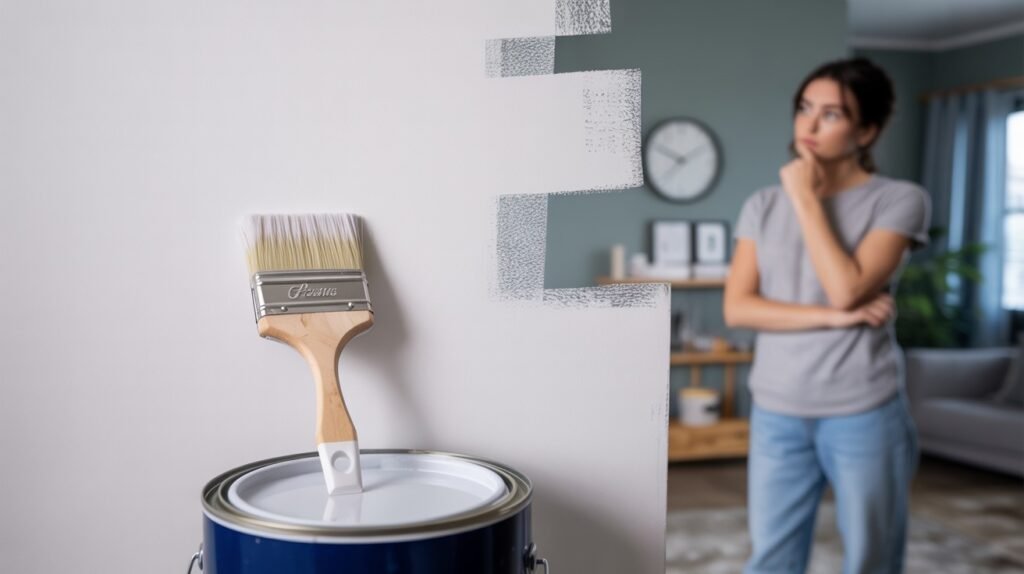You’re staring at your freshly painted wall, brush in hand, ready to apply that second coat.
But wait, should you? That nagging question, “how long to wait between coats of paint,” might seem simple, but getting it wrong could turn your weekend project into a costly mistake.
Too eager painters often rush this step, only to watch their beautiful finish bubble, streak, or peel away like old wallpaper.
On the flip side, waiting too long isn’t always better either. Different paints have different personalities; some are ready for round two in just a couple of hours, while others need to sleep on it overnight.
The good news? Once you understand the science behind drying times and learn to read the signs your paint is giving you, you’ll nail perfect results every time.
Why Does Waiting Between Paint Coats Matter?
Think of paint layers like building a friendship; rush the process, and things fall apart.
When you apply a second coat too quickly, you’re essentially asking wet paint to stick to… more wet paint. This creates a recipe for disaster that can ruin hours of hard work.
Prevents Peeling, Cracking, and Uneven Finish
When the first coat hasn’t properly set, adding another layer can cause the underlying paint to lift and bubble.
You’ll end up with an uneven surface that looks more like cottage cheese than a smooth wall. Worse yet, sections might start peeling away completely, leaving you back at square one.
Ensures Proper Adhesion of Next Layer
Paint needs time to form a stable foundation. During the drying process, solvents evaporate and the paint film hardens.
If you interrupt this process, the second coat can’t grip properly, leading to weak spots that will show their true colors (literally) down the road.
Affects Durability and Final Appearance
Patience pays off in longevity. Properly timed coats create a strong, unified finish that resists wear, maintains its color, and looks professionally done.
Skip the waiting period, and you’ll likely find yourself repainting sooner than expected.
General Guidelines by Paint Type
Not all paints are created equal; each type has its timeline for when it’s ready for company. Understanding these differences will save you from costly repainting mistakes.
Latex/Water-Based Paint

Typical wait time: 2-4 hours
Water-based paints are the speed demons of the painting world. Since water evaporates faster than oil, these paints dry relatively quickly.
However, don’t let their quick-drying nature fool you into rushing.
Touch-dry vs fully dry explained
Here’s where many people get tripped up. “Touch-dry” means the surface feels dry to a light touch, usually within 30-60 minutes.
But this doesn’t mean it’s ready for the next coat. “Recoat-ready” happens when the paint has cured enough to accept another layer without lifting or mixing.
For latex paints, this sweet spot typically occurs between 2-4 hours, depending on conditions.
Oil-Based Paint

Typical wait time: 6-24 hours
Oil-based paints are the marathon runners; they take their time but deliver lasting results. These paints cure through oxidation, a chemical process that’s much slower than simple water evaporation.
Longer curing period due to the oil content
The oil in these paints needs time to react with oxygen in the air, forming a hard, durable film.
This process can’t be rushed, and applying a second coat too early will trap solvents underneath, leading to soft spots and poor adhesion.
Plan for at least 6 hours minimum, but 12-24 hours is often safer, especially in humid conditions.
Spray Paint

Typical wait time: 15-30 minutes (light coats)
Spray paints dry fastest of all, thanks to their thin application and fine mist delivery. The solvent evaporates quickly, leaving a thin film that’s ready for the next coat in just 15-30 minutes.
Risks of overspraying too soon
With spray paint, the temptation to add coat after coat quickly is strong. However, applying too much too fast can cause runs, drips, and an orange-peel texture.
Light, even coats with proper timing will give you that smooth, professional finish you’re after.
Surface Matters: What You’re Painting Affects Drying
Your paint doesn’t exist in a vacuum; it’s having a conversation with whatever surface lies beneath.
Different materials interact with paint in unique ways, and understanding these relationships will help you time your coats perfectly.
Drywall vs Wood vs Metal vs Masonry
Drywall is like a thirsty sponge, especially if it’s new or unprimed. It absorbs moisture from the paint, which can speed up surface drying but may require longer between coats to ensure the paint film has properly formed.
Wood presents its challenges. Softwoods like pine are more porous than hardwoods like oak, affecting how quickly paint sets.
Grain direction also matters; paint applied across the grain may take longer to level out than paint applied with it.
Metal surfaces don’t absorb anything, so paint sits on top and relies entirely on air circulation and evaporation.
This can mean faster drying in good conditions, but also makes the paint more susceptible to temperature and humidity changes.
Masonry surfaces like concrete or brick are extremely porous and can pull moisture from paint rapidly.
While this might seem like it would speed things up, it can create an uneven drying pattern that requires more careful timing.
Porous Surfaces May Absorb More, Altering Dry Time
Think of porous surfaces as having millions of tiny straws pulling moisture from your paint.
This absorption can create a deceptive situation where the surface appears dry while the paint film itself hasn’t properly cured.
Raw wood, unprimed drywall, and concrete are prime examples. These surfaces often benefit from a quality primer first, which seals the pores and creates a more predictable drying environment for your topcoats.
Environmental Factors That Affect Drying Time
Paint is surprisingly picky about its working conditions. Understanding how environmental factors impact drying will help you plan better and avoid frustrating setbacks.
|
Factor |
Optimal Range |
Too Low/Poor |
Too High/Excessive |
Impact on Drying |
|
Temperature |
50-85°F (10-29°C) |
Below 50°F: Paint becomes sluggish, poor flow, extended cure time |
Above 85°F: Too rapid drying, brush marks won’t level, potential skinning |
Cold slows chemical reactions; heat accelerates but can cause defects |
|
Humidity |
40-70% |
Below 40%: Paint dries too fast, visible brush strokes, poor leveling |
Above 70%: Dramatically slows evaporation, 2-hour job becomes 6+ hours |
High humidity traps moisture; low humidity causes premature surface curing |
|
Air Circulation |
Gentle, consistent airflow |
No airflow: Trapped moisture and fumes, slower drying, poor ventilation |
Excessive wind: Dust particles stick to wet paint, uneven finish |
Moving air carries away solvents and moisture, which can reduce drying time by 30-50% |
|
Indoor Conditions |
Controlled environment with ventilation |
Poor ventilation: Fumes build up, moisture is trapped, and extended drying |
Over-ventilation: Rapid drying, temperature fluctuations |
More predictable, but requires active air management |
|
Outdoor Conditions |
Mild, stable weather |
Morning dew, high humidity, and temperature drops |
Direct sun, high heat, strong winds, and weather changes |
Variable conditions require flexible timing and weather monitoring |
Key Takeaway: Check your local weather forecast for temperature, humidity, and wind conditions before starting your project.
A simple box fan indoors or choosing the right time of day outdoors can make the difference between a smooth process and a frustrating experience.
Conclusion
Getting the timing right between paint coats isn’t just about patience; it’s about understanding the science behind the process.
Remember that latex paints typically need 2-4 hours, oil-based paints require 6-24 hours, and spray paints are ready in 15-30 minutes. But these are just starting points.
Your specific conditions matter enormously. A humid basement will extend these times, while a well-ventilated room with perfect temperature might speed things up.
The surface you’re painting, from porous drywall to non-absorbent metal, also plays a crucial role.
When in doubt, do the touch test; if the paint feels tacky or leaves fingerprints, wait longer.
Taking the extra time now prevents the headache of bubbling, peeling, or having to start over completely.
Frequently Asked Questions
Can I use a hair dryer to speed up paint drying between coats?
Avoid hair dryers as they can cause uneven drying and surface defects that ruin your finish.
What happens if I wait too long between coats of paint?
Waiting too long can reduce adhesion, but it’s generally safer than applying coats too quickly.
How do I know if paint is truly ready for the next coat?
Perform a light touch test; paint should feel dry and not leave fingerprints or marks.

